Kingdom Animalia Subphylum Chelicerata Infraorder Araneomorphae Scientific name Nephila Rank Genus | Phylum Arthropoda Order Araneae Family Nephilidae Higher classification Nephilidae | |
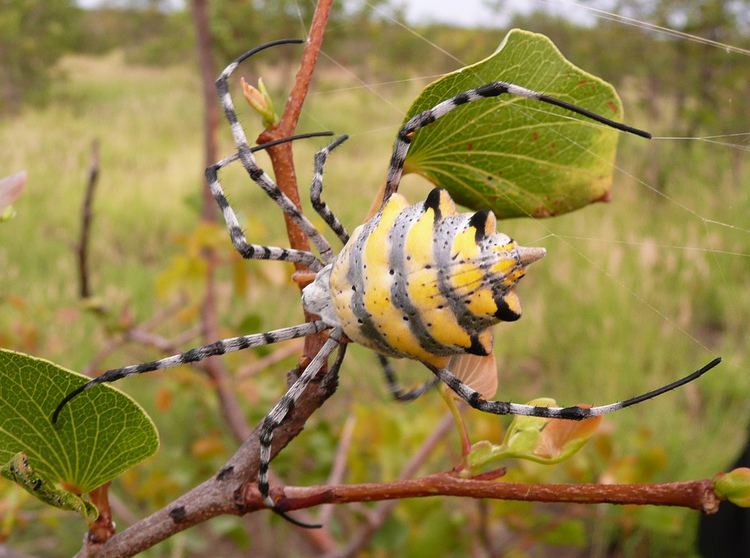 | ||
Lower classifications Nephila clavipes, Nephila pilipes, Nephila clavata, Nephila inaurata, Nephila edulis | ||
The golden silk orb-weavers (Nephila) are a genus of araneomorph spiders noted for the impressive webs they weave. Nephila consists of numerous species found in warmer regions around the world. They are also commonly called golden orb-weavers, giant wood spiders, or banana spiders.
Contents
- Etymology
- Description
- Distribution and habitat
- Web spinning
- Prey capturing mechanisms
- Parasites
- Spiderlings
- Venom
- Interaction with humans
- Golden silk
- References
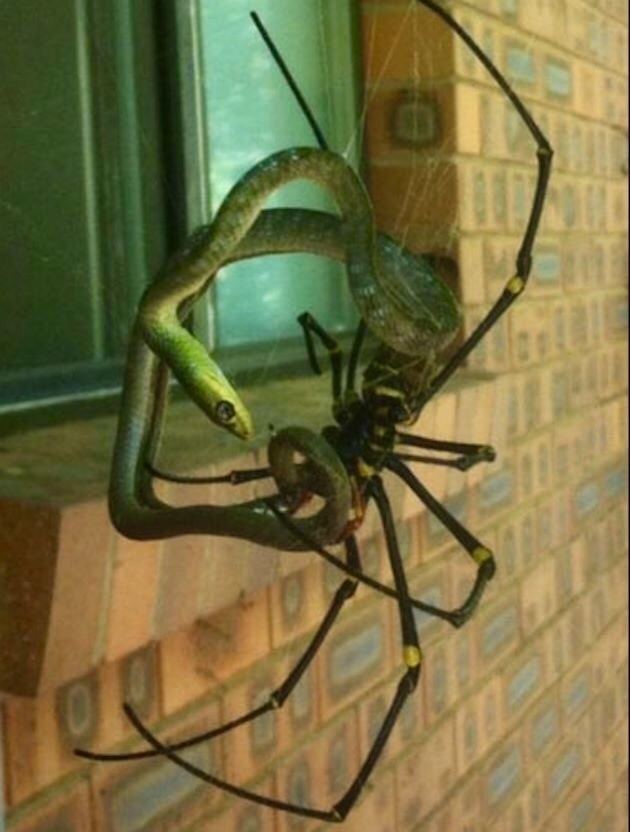
Etymology
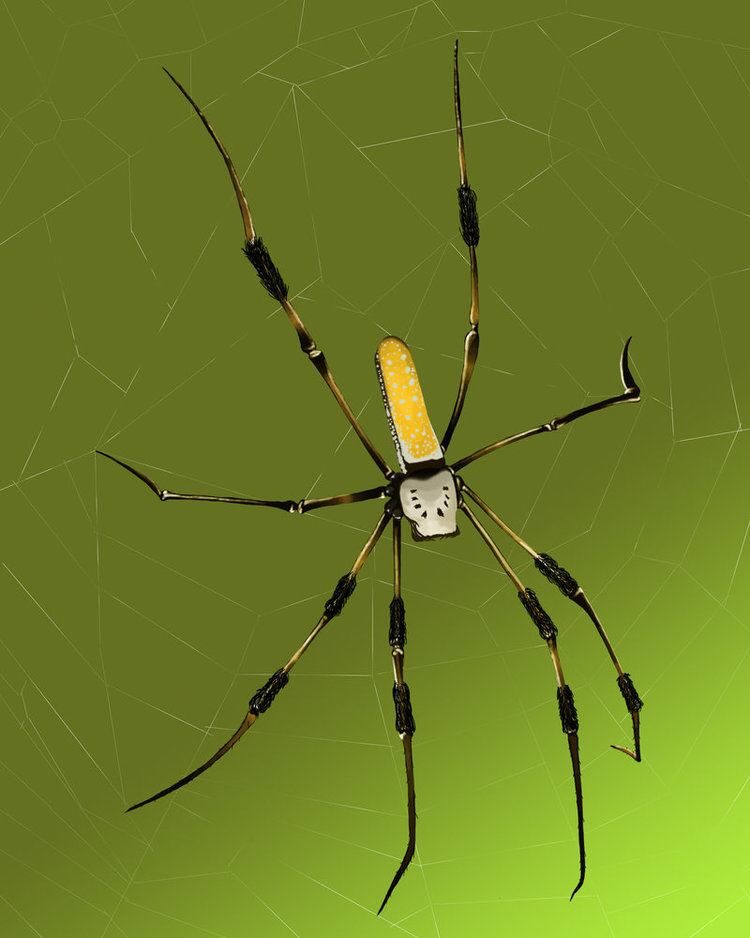
The genus name Nephila is derived from Ancient Greek, meaning "fond of spinning", from the words νεῖν (nein) = to spin (related to nema νήμα "thread") + φίλος (philos) = "love".
Description
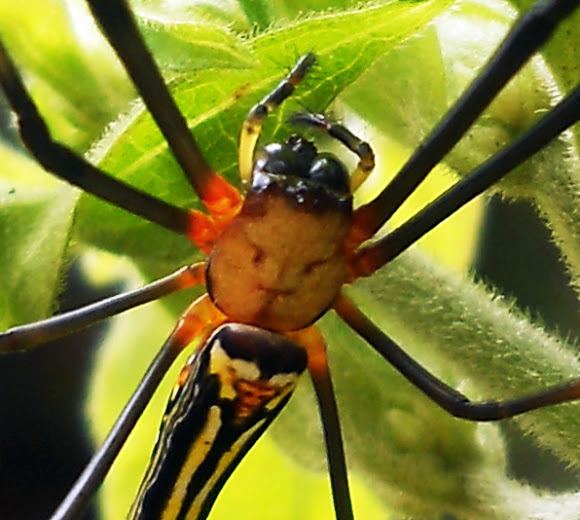
Nephila spiders vary from reddish to greenish yellow in color with distinctive whiteness on the cephalothorax and the beginning of the abdomen. Like many species of the superfamily Araneoidea, they have striped legs specialized for weaving (where their tips point inward, rather than outward as is the case with many wandering spiders). Their contrast of dark brown/black and green/yellow allows warning and repelling of potential predators to whom their venom might be of little danger.
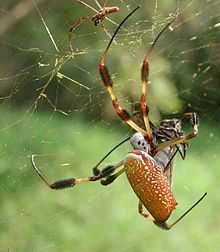
Golden orb-weavers reach sizes of 4.8–5.1 cm (1.5–2 in) in females, not including legspan, with males being usually 2/3 smaller (less than 2.5 cm, 1 in). The largest specimen ever recorded was a 6.9 cm (2.7 in) female N. plumipes (which is now debated to have been a new yet undocumented subspecies) from Queensland, Australia, that was able to catch and feed on a small finch. In 2012 a large individual was photographed killing and consuming a half-metre-long brown tree snake in Freshwater, Queensland. Species from Taiwan have been known to reach over 130 mm (5.1 in), legspan included, in mountainous country. In 2014, a study discovered that golden orb-weavers living in urban areas, particularly those of a high socioeconomic status, grew larger and carried more eggs than those in their native habitats. A number of possible explanations were suggested, such as increased food supplies due to artificial light or lack of predators and parasites.
Distribution and habitat

Golden silk orb-weavers are widespread in warmer regions throughout the world, with species in Australia, Asia, Africa (including Madagascar), and the Americas. One species, N. clavipes, occurs in the United States of America, where it ranges throughout the coastal southeast and inland, from North Carolina to Texas. Spiderlings can be carried by the wind over long distances, and each year, a small number of golden orb web spiders are found in New Zealand (where they are not endemic) after having been blown across the Tasman Sea; the spiders usually end up in the North Island.
Web spinning
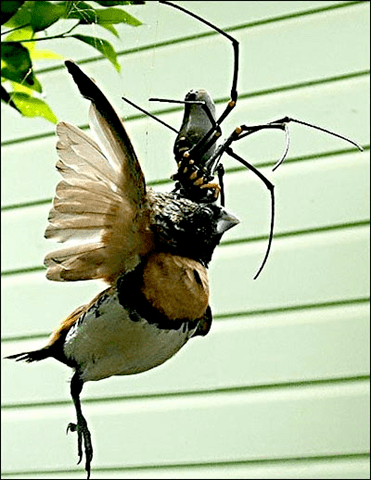
The name of the golden silk orb-weavers refers to the color of the spider silk, not the color of the spider itself.
Yellow threads of their web shine like gold in sunlight. Xanthurenic acid, two quinones and an unknown fourth compound contribute to the yellow color. Experimental evidence suggests that the silk's color may serve a dual purpose: sunlit webs ensnare bees that are attracted to the bright yellow strands, whereas in shady spots the yellow blends in with background foliage to act as a camouflage. The spider is able to adjust pigment intensity relative to background light levels and color; the range of spectral reflectance is specifically adapted to insect vision.
The webs of most Nephila spiders are complex, with a fine-meshed orb suspended in a maze of non-sticky barrier webs. As with many weavers of sticky spirals, the orb is renewed regularly if not daily, apparently because the stickiness of the orb declines with age. When weather is good (and no rain has damaged the orb web), subadult and adult Nephila often rebuild only a portion of the web. The spider will remove and consume the portion to be replaced, build new radial elements, then spin the new spirals. This partial orb renewal is distinct from other orb-weaving spiders that usually replace the entire orb web. In 2011 it was discovered that the web of Nephila antipodiana contains ant-repellent chemicals to protect the web.
Typically, the golden orb-weaver first weaves a non-sticky spiral with space for two to twenty more spirals in between (the density of sticky spiral strands decreases with increasing spider size). When she has completed the coarse weaving, she returns and fills in the gaps. Whereas most orb-weaving spiders remove the non-sticky spiral when spinning the sticky spiral, Nephila leave it. This produces a "manuscript paper" effect when the orb is seen in the sun: groups of sticky spirals reflecting light with "gaps" where the non-sticky spiral does not reflect the light.
The circular-orb portion of a mature N. clavipes web can be more than 1 meter across, with support strands extending perhaps many more feet away. In relation to the ground, the webs of adults may be woven anywhere from eye-level upwards high into the tree canopy. The orb web is usually truncated by a top horizontal support strand, giving it an incomplete look.
Adjacent to one face of the main orb there may be a rather extensive and haphazard-looking network of guard-strands suspended a few inches distant across a free-space. This network is often decorated with a lumpy string or two of plant detritus and insect carcasses clumped with silk. This "barrier web" may function as a kind of early-warning system for incoming prey or against spider-hunting predators, or as a shield against windblown leaves; it may also be remnants of the owner's previous web. At least one reference explains the suspended debris-chain as a cue for birds to avoid blundering into and destroying the web.
Stabilimenta among N. clavipes are sometimes seen in the webs of immatures nearing molt, hence the names "molting webs" or "skeleton webs" (webs with radial strands but no spiral elements).
Prey-capturing mechanisms
The Australian golden silk orb-weaver (Nephila edulis) has been observed on windy, rainy days dismantling the lower part of its web to allow strong wind to flow through a large opening in the web without breaking it. Golden Orb Weavers are known to occasionally eat prey as big as small birds and even snakes.
Parasites
N. clavipes (and many other Nephila species) are frequently parasitized by Argyrodes, a genus of very small black-and-silver spiders that are kleptoparasitic. As many as a few dozen may infest a single Nephila web to feed from the host spider's captured prey. The frequent rebuilding or abandoning of webs by Nephila may be a tactic for controlling Argyrodes. Spiny orb-weaver spiders of the genus Gasteracantha also inhabit the webs of Nephila as kleptoparasites, too.
Spiderlings
Young spiders do not generally build yellow-colored silk, and the young Nephila themselves can be easily mistaken for young Orchard Spiders (Leucauge) in general color and shape (both genera sport silver stripes or patches on their abdomens, described in some references as a form of heat control). The best distinction between Leucauge and Nephila juveniles is web structure: Leucauge tends to build a horizontal orb that is a perfect circle, whereas Nephila build vertical, elliptical orbs that are incomplete (missing the portion of the orb over the hub, the center where the spider sits). Nephila seem to prefer more open habitat such as second-growth scrub or forest edges. Fences or building overhangs often do just as nicely.
In addition, young spiders demonstrate vibrational motion when approached by a predator. They will oscillate at approximately 40 Hz when the web is plucked—thought to be a response to a potential predator. If a predator persists in an attack, the spider will either run to a web-support strand and thus to nearby vegetation, bail out of the web on a silk line that remains connected to the web, or jump from the web after inducing oscillations in the web that aid the jump.
Venom
The venom of the golden silk orb-weaver is potent but not lethal to humans. It has a neurotoxic effect similar to that of the black widow spider; however, its venom is not nearly as powerful. The bite causes local pain, redness, and blisters that normally disappear within a 24-hour period. In rare cases, it might trigger allergic reactions and result in respiratory troubles (in asthmatics) or fast-acting involuntary muscle cramps. As the genus possesses relatively strong chelicerae, the bite could leave a scar on hard tissue (such as fingers).
Interaction with humans
These spiders do not seem to form either beneficial or harmful relationships with humans. As they weave their webs in bushes and near flowers, they might present a nuisance for gardeners or flower pickers. Some nests near fruits may repel or destroy known pests, such as Tephritid fruit flies, without the need to use insecticides.
Golden silk
There have been several efforts in the past to produce garments from Nephila silk although none commercially viable. These include two bed hangings that were shown at the 1900 Paris Exhibition. In 2004 a textile designer, Simon Peers, and an entrepreneur, Nicholas Godley managed in three years work and using 1.2 million Golden silk orb-weavers (collected in the wild and released some 30 minutes later after they produced the silk) to produce a shawl that was as exhibited at the American Museum of Natural History in 2009. By 2012 they managed to produce a second, bigger garment, a cape, that, together with the shawl, were exhibited at the Victoria and Albert Museum in London.
Another possible use of Nephila silk lies in tissue engineering. A study from the Medizinische Hochschule Hannover reports that processed Nephila silk is an excellent scaffold material thanks to its biocompatibility, mechanical strengths, and its property to promote cell adhesion and proliferation. In particular, the silk acts as a suitable guiding material for peripheral nerve regrowth.
Fishermen on coasts of the indopacific ocean remove Nephila webs and form them into a ball, which is thrown into the water. There it unfolds and is used to catch bait fish.
